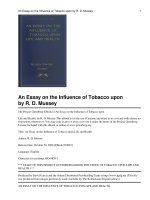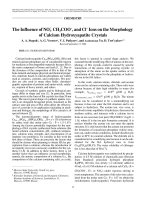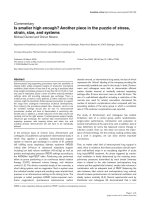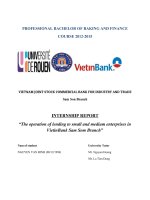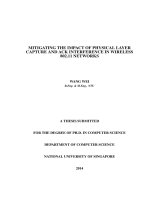The influence of labor market size and social capital to outsourcing decision empirical study for small and medium enterprises in vietnam
Bạn đang xem bản rút gọn của tài liệu. Xem và tải ngay bản đầy đủ của tài liệu tại đây (1.19 MB, 54 trang )
UNIVERSITY OF ECONOMICS
INSTITUTE OF SOCIAL STUDIES
HO CHI MINH CITY
THE HAGUE
VIETNAM
THE NETHERLANDS
VIETNAM – NETHERLANDS
PROGRAMME FOR M.A IN DEVELOPMENT ECONOMICS
The influence of labor market size and social capital to
outsourcing decision: Empirical study for Small and
Medium enterprises in Vietnam
A thesis submitted in partial fulfillment of the requirements for the degree of
MASTER OF ARTS IN DEVELOPMENT ECONOMICS
By
LE DUY MINH
Academic Supervisor:
Dr. PHAM KHANH NAM
HO CHI MINH CITY, DECEMBER 2016
1
DECLARATION
“I certify that the substance of this thesis has not already been submitted for any
degree and have not been currently submitted for any other degree.
I certify that to the best of my knowledge and help received in preparing this thesis
and all sources used have been acknowledged in this thesis.”
HCMC, December 2016
Signature
LE DUY MINH
2
ACKNOWLEDGEMENTS
For the completion of this thesis, I would like to express my gratitude to the
University of Economics Ho Chi Minh City in Vietnam and the Institute of Social Studies
The Hague in The Netherlands for developing the Vietnam – Netherlands Programme for
M.A in development economics.
I would like to express my thanks to my teachers and family who have given me
tremendous encouragement for completing this thesis.
I wish to express a special gratitude to my supervisor, Dr. Pham Khanh Nam, for all
of his supports and advices during the process of completing this thesis.
Last but not least, I wish to say thanks to all of my friends during my time in the
VNP for being a source of great encouragement.
3
ABSTRACT
The purpose of this paper is to provide an insight to the impact of labor market size
and social capital on the outsourcing decision in Vietnam Small and Medium enterprises,
using the data collected in 2013. Logit binary model is employed to explore the effect of
labor market size and social capital on firm’s probability to outsource. The result
indicates that there is connection between firm’s social capital and outsourcing decision.
While the link between labor market size and outsourcing in Vietnam is not proved to be
significant in this research, the study does not reject the importance of market
environment to outsourcing but suggest finding a more appropriate variable to quantify
market condition.
Keywords: outsourcing, social capital, labor market size, Vietnam SMEs
4
TABLE OF CONTENTS
CHAPTER 1 INTRODUCTION...................................................................................................... 7
1.1
Problem Statement.................................................................................................................. 7
1.2
Research Objectives and Questions ................................................................................... 9
1.3
Scope of Research .................................................................................................................. 9
1.4
Thesis Structure ..................................................................................................................... 10
CHAPTER 2 LITERATURE REVIEW ..................................................................................... 11
2.1
2.2
Review of Theory ................................................................................................................. 11
2.1.1
Concept of Outsourcing ............................................................................................ 11
2.1.2
Theoretical studies on outsourcing ....................................................................... 12
2.1.3
Factors of Outsourcing Decision............................................................................ 13
2.1.4
Benefits and Risks of Outsourcing ....................................................................... 16
2.1.5
Determinants of Outsourcing .................................................................................. 18
Review of Empirical Studies ............................................................................................. 21
CHAPTER 3 RESEARCH METHODOLOGY ...................................................................... 23
3.1
Analytical Framework ......................................................................................................... 23
3.2
Econometric Model .............................................................................................................. 24
3.2.1
Model Specification .................................................................................................. 24
3.2.2
Variables Measurement ............................................................................................ 25
3.2.3
Model Implementation ............................................................................................. 28
3.2.4
Data ................................................................................................................................ 30
CHAPTER 4 RESEARCH RESULT........................................................................................... 34
4.1
Overview of SMEs in Vietnam ......................................................................................... 34
4.2
Descriptive Statistics............................................................................................................ 35
4.3
Regression Results ................................................................................................................. 40
5
CHAPTER 5 CONCLUSION ......................................................................................................... 45
5.1
Conclusion and Policy Implication .................................................................................. 45
5.2
Study Limitation ................................................................................................................... 46
REFERENCES ..................................................................................................................................... 48
6
CHAPTER 1
INTRODUCTION
1.1 Problem statements
Outsourcing is defined as the practice of one firm to contract out their value-creation
activities to a third-party vendor, ranging from design, research development and service
provision (Hindle, 2005). While this concept is widely thought to be recently prominent,
its root may have dated from the 1970s and 1980s in an effort by several firms to raise
their efficiency and to look for outside assistance for their peripheral processes (Corbett,
2004). Among the earliest practices of this concept, the outsourcing deal between Kodak
Eastman Company & IBM in 1989 received major global attention as Kodak decided to
obtain services from the famous IT specialist. This agreement, while initially receive
criticism and doubt, gradually proved to be effective as Kodak could focus all their
resources in their core competency and become a major player in the photography
industry (Dickson, 2011).
More than 25 years after that business deal, more so with the emergence of
information industry, outsourcing has become an integral part in the highly-competitive
modern business due to its capability to capture scale economy that results in availability
of low resource cost and higher quality due to full attention in the core value-creation
process. Narayanan (2009) identify four strategic purpose of outsourcing: managing cash
flow, managing control over payment, scaling resources and improve the end-product
quality. Magretta (2003) research in the car industry during 1990s show that firms that
take most advantage of outsourcing, like Toyota, Honda & Chrysler earns a considerably
higher profit compared to more traditional firm that relies more on their own capability,
such as General Motors.
On the other hand, firms are also exposed to the risk of outsourcing which is the
difference between what the outsourcing employers require and what is actually produced
by the outsourcing contractors. This difference is created due to different reasons, which
7
includes unrealistic expectation from the employers due to inflated information on the
capability of the outsourcing subcontractors, misunderstanding between the employers
and the contractors over the requirements of the products, generally poor performance by
the subcontractors due to the lack of control, conflicting interests. Some firms also avoid
outsourcing to protect and boost their knowledge knowhow (Hamel & Prahalad, 1994).
The benefits that outsource provide, thus, could be greatly restricted by the threats
associated with it. Outsourcing therefore is a difficult decision to make that requires clear
analysis of different influencing factors (Antonietti, 2016).
Several studies have focused on the firm’s internal elements that determine an
outsourcing decision, which is mostly linked to the transaction cost theory (Michael &
Michael, 2011). On the other hand, very limited studies concentrate on the
macroeconomics factors that favor or discourage outsourcing environment. A positive
business environment will foster collaboration based on fostering trust, softening the
difference between the outsourcing parties and presenting the firm with wider choice for
outsourcing options. Social capital is considered as an integral element of the business
condition to support outsourcing. Bourdieu (1986) defined social capital as “the sum of
the resources that the firm can access by virtue of having a durable network of
relationship”.
Another important factor that contributes to the outsourcing decision is labor market
size. Labor market size is related to the firm’s direct access to human skill and
infrastructure thus affects its decision to outsource.
Vietnamese economy has experienced a major amount of changes from its centrally
planned economy until “Doi Moi” policy that replace the inefficient subsided economy
with an open and market integrated model (Beresford, 2008). Economy greatly improved
during 1990s with the country removing economics border with foreign business partner.
Growth continues to improve to the peak of 8.5% in 2007, in part due to the
Government’s regulation to encourage private sector and improve export and high
foreign investment. During these years Vietnam emerged as an ideal destination for
8
outsourcing production for foreign companies because of cheap labor with high level of
education. Local social capital during this time immensely benefited from the knowledge
shared by international companies and generally better access to the global resources,
even more so after the membership of Vietnam into the WTO in 2007 (Hays, 2014). On
the other hand, Vietnamese companies have started to outsource its operation. In
principle, when a company makes an outsourcing decision, its aim is to maximize profit
by comparing costs and benefits stemming from the decision. However, there are many
barriers and drivers to this decision. Understanding these barriers and drivers could help
companies to make better decision on outsourcing.
The study will look into the year of 2013, five years after the economic slump in
2008 due to high inflation and global economy crisis that hampers the economy and sink
the annually growth to the bottom in 2012. This paper aims to contribute to the existing
literature about the determinants of outsourcing.
1.2 Research objectives & questions:
The purpose of this research is to analyze the influence of local labor market size and
social capital to the outsourcing decisions of Vietnamese small and medium enterprises.
The main questions that will be answered at the end of this study are:
For Vietnam small and medium enterprises, does labor market size affect the
outsourcing decision?
For Vietnam small and medium enterprises, does social capital affect the
outsourcing decision?
1.3 Scope of research
This research focuses solely on Vietnamese firms as outsourcing employers, not as
outsourcing subcontractors. It analyzes the impact of social capital and local labor market
size to the decisions of Vietnamese firm to outsource or not by employing the logistic
regression model. Data is collected on Small and Medium Enterprises (SME) of Vietnam
for the year of 2013.
9
1.4 Thesis structure
The research is categorized into 5 separated chapters:
Chapter 1: Introducing the research
This chapter offers a background for outsourcing as a global business practice and a
review of Vietnam economy. The research gap, question and scope are also identified.
Chapter 2: Literature review
This chapter examines the existing literature regarding the factors that surrounds the
outsourcing decision as well as the role of local labor market size and social capital in
outsourcing. Theoretical and empirical evidences are analyzed.
Chapter 3: Research methodology
In this chapter, the econometrics model will be determined with the purpose of answering
the research question. The dataset and variables used in the model will be presented and
explained in full detail.
Chapter 4: Research Results
This chapter presents the important information regarding each individual variables and
their connection after conducting the research methodology.
Chapter 5: Conclusions and policy implementation
Key findings and areas of possible improvement for future research will be identified.
10
CHAPTER 2
LITERATURE REVIEW
2.1 Review of theory
2.1.1 Concept of outsourcing
Outsourcing is a concept that has been differently defined in the literature. Early
definition of outsourcing includes the study of Kotab (1992), who describes outsourcing
as the practice of a firm to get supplied products and product components from other
independent firms around the world. Lei and Hitt (1995) views outsourcing as the firm’s
dependence on resources and components for their value-adding activities. However
these definitions are considered as too general and easily to be confused with normal
procurement activities, as none of the firm is excluded from transaction activities with the
others (Gilley & Rasheed, 2000).
Gilley and Rasheed categorize outsourcing into two types: substitution and abstention
outsourcing. In substitution outsourcing, the firm replaces one of its former internal
activities to seek for external supply. This “vertical disintegration” withdraws the firm’s
resources in the outsourced activity to focus in other area. In abstaining outsourcing, the
firm also relies on external party for goods/services purchase; however these products
have not been internally produced by the firm before. This method is still considered
outsourcing, which differs from normal procurement in the way that the managerial and
financial capacity of the firm allows them to internalize these goods/services should they
wish to do so. In general, we can differentiate outsourcing and normal transaction by the
firm’s ability to conduct the outsourced activities on their own.
This study employs the adequate and clearly-defined term of marketing from Sanders
et al (2007): Outsourcing is defined as the firms’ practice to contract out part of its
activities to a third party firm; with the purpose of concentrating its own financial
11
capacity, personnel, facilities and resources into their main value-creation activities that
is considered essential.
2.1.2 Theoretical studies on outsourcing
Among the in-depth studies of outsourcing, two theoretical perspectives that have the
most association with outsourcing are transaction cost theory and resource-based view
theory.
Transaction cost theory
An outsourcing decision is dependent in 2 types of cost: production cost, which the direct
cost of production from the third party and transaction cost, which is the cost to make
sure that the subcontractors act in accordance to the expectation of the firm. Williamson
(2008) argues that transaction cost is the critical factor of outsourcing decision. He
applies the different categories of transaction cost, proposed first proposed by Dahlman
(1981), as search cost – the cost to identify product providers that have the capacity for
the outsourced activities, selection cost – cost of choosing a specific supplier, bargaining
cost – cost of determining the outsourced price, enforcement & coordinating cost – the
cost associated with monitoring the subcontractor to ensure that they do not act on
opportunity and violate the contract.
The link between outsourcing and transaction cost comes from the firm need to make
sure the subcontracting acts exactly as what is specified in the contract, from the quality
of the end products/services, to the compliance to the standards if the production process,
to any legal fees if contract violation occurs. Without these control however firm run the
risk of lower output, lower quality and having to find the alternative options for their
production.
Resource-based view theory
In the resources based view theory, firms develop their competitive edge by the way they
effectively deploy their resources pool – comprising of tangible and intangible
12
elements.(Wernerfeld, 19954). Competitive advantages are sustained only when the
resourced are used in the most effective way, and the resources hold by the firm is
distinctive compared to the competitors. In relation with outsourcing, firms create an
access to the resources outside their boundary either when they observe a more advanced
resources pool in the external environment for a particular product, or when they want to
reorganize their resources management and focus. In both way, firms aim to a better
product/service by outsourcing. In the time when firms are more inclined to contract out
products with high skill requirements, resource-based view complements transaction cost
theory by adding the quality aspect of outsourcing.
2.1.3 Factors that determine outsourcing decision
Cost
Saving cost is a prime purpose that the firm chooses to outsource for. In general,
outsourcing has cost advantage when the cost of relying on the subcontractors - including
transaction cost and profit - is lower than the cost of in-house production (Harler, 2000).
Since additional production cost for peripheral activities are associated with overhead
cost and capital expenditure (Muscato, 1998), outsourcing is considered a viable option to
take advantage of the economies of scale and the skill specialization of the outsourced
firms (Adler, 2000). By transferring such fix cost of production into the variable
contractual cost with the subcontractors, outsourcing could further reduce the financial
risk for the outsourcing employers (Blumberg, 1998; Kakabadse & Kakabadse, 2000).
Indirect cost is also significantly decreased by outsourcing: As the firm has less labor size
and more concentration of resources, it could better control cost by having a leaner
management system and more efficient organization (Fontes, 2000). Cost outsourcing has
been successfully employed by a large number of firms. One example is the effort of
General Motor in 1998 to outsource all their accounting activities resulted in a reduction
of 20% of the cost in this area (Corbett, 2004).
However, with the goal of cost reduction in mind, the company needs to be sure that they
do not overestimate the cost saved by outsource. Indirect transaction cost of outsourcing,
13
which is originated from the firm effort to control their subcontractors, is often hidden
and could be higher than what the firm perceives (Michael & Michael, 2011).
Transaction cost is related to the activity of searching and upholding reliable business
partners, negotiation, contract formation that controls the parties’ responsibility
(Vasiliauskiene & Snieska, 2009).
Strategy
Strategic factors that could influence outsourcing decision are related to the firm’s core
competency, flexibility and quality impact (Kremic et al, 2006).
On core competency, outsourcing is a mean to increase performance and the quality of
the end product by focusing on its competitive advantages that have the most contribution
to their value-creation process (Prahalad & Hamel, 1990). Moreover, the firm could rely
on their subcontractors’ own core-competency – resources, infrastructure, and skill - to
complement their whole product portfolio. A well-known successful story from this
strategy is ACER’s tactics of outsourcing most of its manufacturing activities and focus
on what it excels at: marketing, branding and sales. The result is one of the most
developed companies in term of sales and market shares growth, having the workforce of
only one-tenth of its largest competitor’s (Heric & Singh, 2010). On the other hand, firm
should carefully consider what should be outsourced without presenting the risk of losing
their critical knowledge base and giving up their market potential (Dekkers, 2011).
On flexibility, outsourcing equips the firm with the ability to efficiently restructuring
their resources and the firm organization, in scope and scale, to respond to technology
development and the fluctuation of the market demand (Lankford & Parsa, 1999). In
addition, the risk that may occur during macroeconomics change will be shared with their
outsourced partners.
14
Function
Outsourcing is also affected by the characteristics of the outsourced function, which is
more unique and firm-specified. Kremic (2006) separates this factor into 4 different
categories: complexity, integration, asset specificity and structure.
Complexity is the capability of the function to be well-defined and understood in details,
with its interaction to the surrounding environment clearly identified. Complexity is an
important factor in outsourcing contract because it directly affects the subcontractors’
understanding of the purpose and the term of the outsourcing employers regarding the
outsourced function. The more complex the function is, the higher cost that is required to
monitor and the lower motivation to outsource (Franceschini et al, 2003).
The second category is interaction. In the value-creation process of the firm, interaction
refers to the degree at which the particular function synergizes with other function in the
system. If the function reserves a central role inside the system, moving the function
outside of the firm to outsource will be difficult due to the effort made to closely
coordinate with the department that is affected (Prencipe, 1997).
Asset specificity relates to how the output generated by outsourcing is of any importance
outside the firm boundary. If the output could only be useful for that specific function,
the outsourcing subcontractors will be less likely to commit their resource to improve the
output, as their interest differs with the interest of the outsourcing employers.
Structure specifies the degree to which the tasks in the function is pre-determined and
follows a predictable order. Function with simple structure is more likely to be
outsourced since it can be easily implemented with great compliance,, and the functions
are often the non-core activity of the firm (Kremic et al, 2006).
15
To summarize, some functions have more incentive to be outsourced than the other. The
difficult it is to outsourced, the more expensive it will be when switching the
subcontractors (Franceschini et al, 2003). While function refers to different rings inside
the firm’s value creation chain, it can be applied with firm level as well, as different
companies possess different characteristics that are related to their viewpoint on
outsourcing.
Environment
This factor involves the external environment that surrounds the organization and is
related to the concept of social capital. Social capital is a complex concept that is based
on the behavior between different elements inside the local market. This involves socioeconomic factors that are economic growth, financial development, and level of
innovation, crime rates, education, entrepreneurship and regional development. Social
capital is also examined in the field of organizational science, labor economics and game
theory, which describe it as a determinant of government’s structure that determines trust,
opportunism behavior, avoidance of shirking behavior and reputation building in one-off
transaction. In general, social capital conveys a system of shared values and beliefs and
build on mutual trust and cooperation that heavily reduces transaction cost, improve the
efficiency of coordinated action between the outsourcing and outsourced firms and
benefit the ones who live by the standard of the general policy (Antonietti, 2016).
2.1.4 – Outsourcing benefits & risks
A summary of the advantages and disadvantages of outsourcing will be summarized in
the table below:
16
Table 1 – Benefits and risks of outsourcing
Expected benefits
Risks
Saving cost, reducing capital investments, Overestimating saved cost, underestimating
reducing financial risk
(Kadabadse
&
hidden/transaction cost
Kadabadse,
2000; (Antonucci et al, 1998)
Blumberg, 1998)
Improving management efficiency
Losing organizational synergy
(Wilcocks et al, 1995)
(Campbell, 1995)
Improving quality, speed & flexibility
Overdependence on the subcontractors
(Jennings, 1997; Razzaque & Chen, 1998)
(Dekkers, 2011)
Accessing to external skill & resources
Subcontractors do not meet skill/resources
requirement
(Gordon & Walsh, 1997)
(Kremic et al, 2006)
Accessing to knowledge & innovation
Losing knowledge and competitive edge
(Muscato, 1998)
(Lei & Hitt, 1995)
Focusing
on
core
competencies, Eroding internal knowledge base, losing
disintegrating “difficult” function
market scope potential
(Crone, 1992; Quinn & Hilmer, 1994)
(Kremic et al, 2006)
Building
trust
with
business Conflict of interest & business environment
partners/subcontractors
uncertainty
(Gilley & Raseed, 2000)
(Wilcocks et al, 1995)
17
Avoiding legal constraints and restrictions
Losing customer perception & reputation
(Kadabase & Kadabadse, 2000)
(Blumberg, 1998)
2.1.5 – Determinants of Outsourcing
Outsourcing is different in different business activities / production stages:
Compared to the researches about the impact of outsourcing to firm competitiveness,
fewer studies have separated the value creation chain process of the company to research
outsourcing in different stages of the process. Hatonen & Erikson (2009) employed a
firm-based perspective to identify the business stages that corporation choose to
accomplish in-house production instead of contracting out, and vice versa. Arnold (2000)
segregated the outsourced activities into four types: core, core close, core-distinct and
disposable. Love and Roper (2001) focused on the stages in the innovation process, while
Cusmano (2009) use the different area in value creation process that includes production,
R&D, design and service activities. The above researches however, have the similarity in
the limitation of number of observations.
The study does not take into account the difference outsourcing activities for
different stages due to the lack of data for Vietnam SME which is considered a limitation.
Outsourcing is affected by local labor market size
In this study, local labor market size is quantified by the labor size of the province
where the firm is located at. The local labor market thickness of the province represents
the availability of local human capital, skill and infrastructure that reinforces firm’s direct
access to different resources. As the main reason for outsourcing for the firm is to taking
advantages of resources that is hard to access from the firm’s location; by using such
local resources in the province, firm is better off by internalizing their production and
taking advantages of the economies of scope rather than risking an amount of transaction
cost for outsourcing partners (Bresnahan & Levin, 2012). Thus, the relationship between
local labor market size and outsourcing decision is expected to be negative. In support of
18
this assumption, the empirical study of outsourcing in a global economy (Grossman &
Helpman, 2001) suggests that firm has the incentive to outsource in an area where market
thickness is higher compared to the local market where the firm is located at.
Outsourcing is affected by social capital
Social capital is defined as the environmental or the organizational characteristics of
networks, norm and trust (Putnam, 1995). Social capital is viewed as an intangible value
that could be invested by the firm’s tangible resources to gain benefit through
information and resources accessibility (Fukuyama, 1995). In business environment, it
encourages knowledge transfer among different individuals and groups, which in turns
develop a business tendency of reciprocity, openness and trust that encourage firms to
outsource from each other (Masciarelli et al, 2011). For individual firms, social capital
capability is the mean through which they generate a relation network that provide them
with the access to the market knowledge. This is even more essential for small and
medium enterprises in making the outsourcing decision, as both do not have enough
resources to control external factors but to rely on them.
Outsourcing decision is affected by social capital through the decrease of transaction
cost. Under an outsourcing contract with the subcontractors, the firm are interested in
making a rational decision. Transaction cost occurs, however, because of information
asymmetry leading to several difficulties to the firms: First, valuable and trusted
information may not be available. Second, the firm may not have enough knowledge base
to efficiently utilize the information y and finally the firm only has a definite amount of
time to make the outsourcing decision (Hobbs, 1996).
Information asymmetry creates the condition for opportunistic behavior by the
outsourcing subcontractors to gain benefit on their side in exchange of the outsourcing
employers (the firms) interest. Opportunistic behavior occurs in two ways: ex-ante
opportunism and ex-post opportunism (Priyanath & Premaratne, 2015). Ex-ante
opportunism happens before the contractual term is agreed in the effort of the
subcontractors to misdirect their outsourcing employers. Ex-post opportunism comes
19
after the contract is finalized to hide the subcontractors’ activities with respect to the
mutual agreement. Opportunistic behavior increases transaction cost, which the rational
firms hope to minimize by having reliable source of information.
Information asymmetry and transaction cost could be controlled by social capital in
all of their dimensions: The structural, relational and the cognitive dimension (Nahapiet
& Gloshal, 1998). Structural form looks to the firm network relationship system and its
attributes, which are expressed through the number of business contacts, the density of
interaction and the complexity within the network. Structural social capital assists the
firms by increasing their knowledge of the network members, encouraging good-will
through close contacts and improving the quality of information base. Relational social
capital is related to a more informal connection between the firms and their partners
(including outsourcing subcontractors) after multiple encounters. This dimension of
social capital provides the firms with trust and personal identification, which discourages
opportunistic behavior due to genuine goodwill and close relationship (Svensson, 2001).
Cognitive form of social capital refers to the mutual understanding between the network
members by the proximity of their vision, objectives, language and business practice,
which enable mutual learning. With cognitive social capital, firms could reduce
asymmetrical information due to the enhanced communication between firms with the
network members (Tsai & Gloshal, 1998)
The relationship amongst social capital, transaction cost and outsourcing decision is
visualized by the figure below (Adapted from Priyanath & Premaratne, 2015).
20
Social Capital
Transaction cost
Structural dimension
(network contacts)
Relational dimension
(personal goodwill)
Opportunistic
Behavior
Information
Cognitive dimension
(understanding)
Firm difference
Ex-ante TC
Searching,
Selecting,
Bargaining
Ex-post TC
Coordinating &
Contract
Enforcement
Outsourcing decision
Figure 1 – Relationship amongst social capital, transaction cost and outsourcing
decision
2.2 . Review of empirical studies
Empirical studies on the determinants of outsourcing have been implemented, both
by qualitative and quantitative method. For qualitative method, Niskanen (2013) analyzes
the mining industry in Finland with qualitative case study research and confirms a high
link between firm’s internal characteristics and environmental factors with the firm’s
decision to outsource. Akbari (2013) conducts an in depth research into the factors that
affect outsourcing decision in Iranian industry, using an extensive questionnaires to assist
both qualitative and quantitative research and confirms that outsourcing decision is
impacted by the skill and knowledge inside the industry, the firm’s access to such skill
and knowledge, the cost factor and customer pressure.
For quantitative method, Girma and Gorg (2004) uses the firm level dataset in
chemical, engineering and electronics manufacturing in the UK and concludes that
average production cost is greatly correlated with outsourcing motive. When faced by
high production cost, mostly due to higher wage, firms tend to slash the cost by
21
contracting out their production. Tomiura (2015) uses the sample of 118300 firms of
Japanese and proves that there is significance connection between the firm’s financial
performance, R&D and skill intensity with outsourcing probability. Diaz-Mora &
Triguero (2006) employs the probit model to quantitatively analyze the influence of firm
characteristics, industry size and innovation investment into outsourcing and observes
that firm size, wage and innovation level has a significant impact. Antonietti (2016)
employs a research on how local labor size and social capital affect outsourcing decision
in different stages of production for Italian manufacturing firms and concludes that local
labor size and social capital have high impact on the full outsourcing decision of the firm.
For local labor size, the relationship is significant during the early processing and
treatment stages of production process. For social capital, the relationship is significant
during the assembly, final processing and post production.
For both type of empirical study, the firm’s internal characteristics are also important
determinants of outsourcing, which is linked to the strategic and functional factors of
outsourcing.
22
CHAPTER 3
RESEARCH METHODOLOGY
3.1.
Analytical framework:
The framework is built on the factors that influence the outsourcing possibility of a
firm, which is identified as its own internal characteristics, the labor market size in which
the firm operates and the social capital of the firm expressed through its network
contacts. The research will also determine the possibility of the interaction between labor
market size and the firm social capital using specification test
Firm internal attributes: age,
average unit cost, skill intensity,
size, market scope,
subcontracting status
Firm’s decision for
outsourcing production
Labor market size
Firm social capital:
Number of business contacts in
the same sector
Number of business contact in
different sectors
Number of contacts with bank
Number of contacts with
politicians or other civil servants
Figure 2: Conceptual Framework
23
3.2. Econometric models
3.2.1 Model specification
The regression is based on the model built by Antonietti (2016) in his study for the
impact of local labor market size and social capital for Italian firms. This model
establishes the relationship between the dependent variable – whether firm outsources,
and the independent variables; which includes the firm internal characteristics (age,
average unit cost, skill intensity, size, share of revenue on subcontracting), local labor
market size and firm social capital (business network size in same sector, different sector,
with bank and with politicians). Since the dependent variable is a binary outcome,
logistic regression is employed.
The general function for this study is presented as:
log
𝒑 (𝒀𝒊𝒑=𝟏)
𝟏−𝒑(𝒀𝒊𝒑=𝟏)
= 𝑎0 + 𝑎1 x 𝑎𝑔𝑒𝑖 + 𝑎2 x 𝑎𝑣𝑒𝑟𝑎𝑔𝑒_𝑢𝑛𝑖𝑡𝑐𝑜𝑠𝑡𝑖 + 𝑎3 x 𝑤ℎ𝑖𝑡𝑒_𝑐𝑜𝑙𝑙𝑎𝑟𝑖 + 𝑎4 x
𝑠𝑖𝑧𝑒𝑖 + 𝑎5 x 𝑠𝑢𝑏𝑐𝑜𝑛𝑡𝑟𝑎𝑐𝑡_𝑠ℎ𝑎𝑟𝑒𝑖 + 𝑎6 x 𝑙𝑜𝑐𝑎𝑙𝑖 + 𝑎7 x 𝑔𝑙𝑜𝑏𝑎𝑙𝑖 + 𝑏1 x 𝑚𝑎𝑟𝑘𝑒𝑡𝑠𝑖𝑧𝑒𝑝 +
c1 x 𝑣𝑛𝑤_𝑠𝑎𝑚𝑒𝑠𝑒𝑐𝑡𝑜𝑟𝑖 + c2 x 𝑣𝑛𝑤_𝑑𝑖𝑓𝑓𝑠𝑒𝑐𝑡𝑜𝑟𝑖 + c3 x 𝑣𝑛𝑤_𝑏𝑎𝑛𝑘𝑖 + c4 x
𝑣𝑛𝑤_𝑝𝑜𝑙𝑖𝑡𝑖𝑐𝑠𝑖 + ε
Where:
i is the firm and p is the province in which the firm is located
outsource: The dependent variable y that takes a value of 1 if the firms outsource
production in 2012, and takes a value of 0 if not
agei : The age of the firm i
average_unitcost i : Average cost per unit of most important product for firm i
white_collari : Share of white collar employees at firm i
sizei : Number of full time employees at firm i
subcontract_sharei : Share of revenue of firm i that comes from production for a thirdparty
24
locali : Binary data that has the value of 1 if the firm’s market is only based in their local
province, of 0 otherwise
globali : Binary data that has the value of 1 if the firm’s has a market share outside of
Vietnam, of 0 otherwise
labormarketsizep : Labor market size of province p
vnw_samesectori : Firm i’s network contacts level with business in the same sector
vnw_diffsectori : Firm i’s network contacts level with business in different sector
vnw_bank i : Firm i’s network contacts level with banks
vnw_politicsi : Firm i’s network contacts level with politicians / civil servants
3.2.2 Variables Measurement
Dependent variables
Outsource: This is a categorical variable that takes a value of 1 if firm outsources
their production during the end year and a value of 0 if firm does not. In the logistic
regression, the probability that the firm outsources (outsource = 1) will be regressed with
the independent variables.
Independent variables
The definition of the independent variables used in this function, with their expected
sign and explanation will be summarized in the below table.
25
